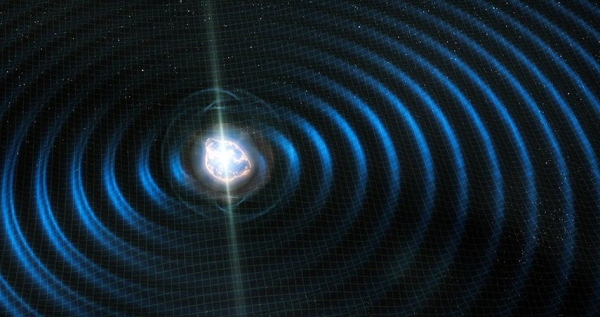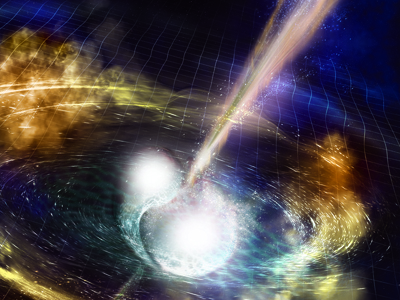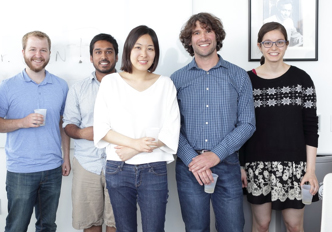
UChicago physicists calculate expansion rate of universe using breakthrough research
CHICAGO—(ENEWSPF)—October 16, 2017
By: Louise Lerner
About 130 million years ago, two incredibly heavy, dense neutron stars spiraled around each other. Their dance brought them closer to one another and made them spin faster, until they were circling more than 100 times per second. The ensuing collision sent a shockwave through the very fabric of spacetime, which traveled across the universe at the speed of light until it rippled through the Earth at 7:41 a.m. Central time on Aug. 17, 2017.
The U.S.-based Laser Interferometer Gravitational-Wave Observatory (LIGO) and the Virgo detector in Italy announced on Oct. 16 that all three of their detectors had picked up the ripples, or gravitational waves, from this event. Two seconds later, a satellite looking for gamma rays registered a burst from the same direction of the sky.
The event was the first time humans have directly observed two neutron stars, the collapsed cores of bigger stars, smashing into one another. Unlike the black holes that merged in LIGO’s first detection of gravitational waves two years ago—a breakthrough that earned this year’s Nobel Prize in Physics—the newly married neutron stars gave off a bright flash of light visible for days afterward. That allowed the world’s most advanced telescopes to point in that direction of the sky, including the Dark Energy Camera in Chile and the Hubble Space Telescope and Chandra X-ray Observatory in orbit above the Earth.
The result is the first measurement of a gravitational wave event in multiple mediums—optical, gamma ray and X-ray as well as gravitational waves—and scientists said the combination opens a wealth of new scientific discovery.
This includes determining the precise location of the galaxy where the event happened, which no previous LIGO detection has been able to do. They also confirmed that gravitational waves travel at approximately the speed of light, verifying a century-old Einstein prediction. And they used gravitational waves to directly calculate the rate at which the universe is expanding.
“Any one of these findings would be groundbreaking on its own merits, and here we got all the pieces together in the span of 12 hours,” said Daniel Holz, an associate professor of physics and astrophysics who led the UChicago team, which was involved in both the LIGO and Dark Energy Survey discoveries. “This is akin to seeing the lightning bolt and hearing the thunder. We have just witnessed the birth of a new field of astronomy. It’s been an unbelievable few weeks.”

Illustration by: A. Simon, NSF/LIGO/Sonoma State University
The Hubble constant: Chasing a ‘white whale’
Holz is a co-author on 12 papers published Oct. 16 on the event, including a leading role in one published in Nature announcing an entirely new measurement of the rate at which the universe is expanding.
Originally suggested by famed astronomer and UChicago alumnus Edwin Hubble, this number, called the Hubble constant, is important to such central questions in astrophysics as the age of the universe and the nature of dark matter and dark energy. It’s also at the center of a raging controversy.
Everyone agrees on the ballpark number, but whether it’s exactly 67 or 72 kilometers per second per megaparsec is hotly debated. Different methods of computing the constant spit out different results, and, Holz said, “they disagree by more than they should.”
Gravitational waves should be one of the cleanest ways to compute the number, Holz said, because scientists understand the physics of what’s happening very well. “Other ways involve many more steps and calibrations that we aren’t sure about,” he said, “but gravitational waves give you this very elegant way to perform this fundamental measurement.”
The initial calculations show LIGO’s number smack in the middle of other estimates, at 70 kilometers per second per megaparsec.
In 2006 Holz was the first to suggest the concept of calculating the Hubble constant via gravitational waves from a gamma-ray burst, calling it a “standard siren,” a nod to the term used to describe certain types of supernovas used for the same calculation called “standard candles.”
“Everyone has their white whale, and mine has been to detect the Hubble constant with gravitational waves,” he said. “And now we’ve done it. A few hours after the discovery I sat down and made the plot, and there it was, the culmination of all those years, right in front of me. And it was beautiful.”
A literal and figurative ‘gold mine’
The neutron star merger is also the closest signal to be detected by gravitational waves, and the closest gamma-ray burst—only about 130 million light-years away, as opposed to the first black hole merger, which was more than a billion light-years away. “That’s really in our cosmological backyard,” Holz said.
Neutron stars are unfathomably dense—the weight of one-and-a-half suns packed into a ball just a dozen or so miles across. They give out a fainter gravitational wave signal than black holes, Holz said, so such proximity is necessary to capture them—even for the extraordinary sensitivity of the detectors.
Most scientists, even optimists, predicted it would be a decade before they would see a neutron star collision and be able to take such a measurement in all mediums, he said.
“This event is a gold mine—literally and figuratively,” Holz said. “We’re going to learn an incredible amount about astrophysics and cosmology from studying its properties. We’re also watching the production of most of the gold in the universe,” since initial studies of the event suggest that such star collisions are likely to be the origin of the heaviest elements in the universe, including gold. (Back-of-the-envelope calculations indicate that this single collision produced an amount of gold greater than the weight of the Earth, Holz said.) This solves a decades-long mystery of where about half of all elements heavier than iron are produced.
The researchers also noted the incredible good fortune of the detection’s timing. There are three gravitational wave detectors in the world: two in the U.S. run by LIGO, located in Washington and Louisiana, and one in Italy. The Italian detector had just started up, and the Louisiana and Hanford locations were just a week from shutting down for a year of maintenance. The event took place in the brief three-week window when all three gravitational wave detectors happened to be on—crucial for an accurate triangulation of the location.
Each detector has two identical arms several miles long, held at right angles to one another. Lasers run the length of each arm, perfectly calibrated to combine in tune with one another, unless one arm suddenly becomes slightly shorter or longer than the other—as would only happen if the universe itself is rippling.
Aside from analyzing all of the data they already have, Holz said, they are still measuring the radio waves produced from the ejected material interacting with the surrounding environment.
“We’ll be mining this data for a long time,” he said.
“With this we truly open a new era of astronomy,” he said. “We used to have only one way to look at the sky, but by combining existing telescopes and gravitational waves, we can learn staggeringly more about the universe.”
UChicago, Fermilab part of collaboration
Hundreds of scientists are now sorting through the results. The UChicago LIGO team included postdoctoral fellow Ben Farr (now a professor at the University of Oregon) and graduate students Hsin-Yu Chen (now at Harvard), Zoheyr Doctor and Maya Fischbach, as well as Reed Essick, who started this fall at UChicago as a Kavli Institute for Cosmological Physics Fellow.
The UChicago team works closely with colleagues at Fermi National Acceleratory Laboratory and elsewhere on the Dark Energy Survey, which captured optical pictures of the merger just hours after LIGO and Virgo detected the gravitational waves. The scientists looked by eye at the telescope’s digital photographs for bright spots that hadn’t been there before in the section of the sky LIGO indicated, and found a new source in the galaxy labeled NGC 4993.
“Because we’re on the telescope nearly every night at that time of year, we were able to watch it peak and then fade very rapidly and could precisely map its brightness and color over time,” said Josh Frieman, UChicago professor of astronomy and astrophysics and the director of the Dark Energy Survey. “This development is very exciting for us, because more data on the expansion rate of the universe will help us chart the billion-year history of the cosmic tug-of-war between gravity and dark energy.”

Holz was on a plane from Hong Kong when the Aug. 17 gravitational wave event happened. He landed to dozens of texts and notifications. “I walked off the plane with my laptop held up to my face, and that’s basically how I’ve been walking around ever since,” he said. “Nature has given us these wonderful gifts. We’re all sleep-deprived, but no one’s complaining.”
Citation: “A gravitational-wave standard siren measurement of the Hubble constant.” Nature, Oct. 16, 2017. Doi:
Funding: LIGO is funded by the National Science Foundation and operated by Caltech and MIT. Financial support also came from Germany (Max Planck Society), the U.K. (Science and Technology Facilities Council) and Australia (Australian Research Council). More than 1,200 scientists and some 100 institutions from around the world participate in the effort through the LIGO Scientific Collaboration, which includes the GEO Collaboration and the Australian collaboration OzGrav.
The Virgo collaboration consists of more than 280 physicists and engineers belonging to the Centre National de la Recherche Scientifique (CNRS) in France; the Istituto Nazionale di Fisica Nucleare (INFN) in Italy; the Netherlands’ Nikhef; the MTA Wigner RCP in Hungary; the POLGRAW group in Poland; the University of Valencia in Spain; and the European Gravitational Observatory, the laboratory hosting the Virgo detector near Pisa in Italy, which is funded by CNRS, INFN, and Nikhef.
Source: www.uchicago.edu








